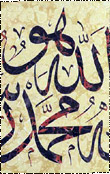| |

| |
 |
| Allahu Veliyyu't |
| |
 |
| Kelime-i Tevhid |
|
|

 |
2
OF 3 |
 |
 While
the new era which he initiated in calligraphy was still in full
swing a century on, Ismail Zühdi (?-1220/1806) and his brother Mustafa
Râkim (1171-1241/1757-1826) developed their own styles inspired
by the finest of Hâfiz Osman's work. Although sülüs had been used
to produce masterful work, its thicker-lined form celî sülüs had
failed to achieve comparable aesthetic quality. Indeed, the celî
form was often execrable, and even the celî of Hâfiz Osman was not
worthy of an artist of such calibre. However, at that time, no one
had been able to do better. It was with Mustafa Râkim that, as in
the case of sülüs and nesih, celî sülüs achieved a superlative excellence
in terms both of the characters and composition that had never before
been matched in any calligraphic style. He achieved this by applying
the manner of Hâfiz Osman in sülüs to celî. Mustafa Râkim also improved
the imperial tugras, which he carried to ultimate perfection. That
is why the celî sülüs script and the tugra can usefully be classified
into the "pre-Râkim" and "post-Râkim" periods. While
the new era which he initiated in calligraphy was still in full
swing a century on, Ismail Zühdi (?-1220/1806) and his brother Mustafa
Râkim (1171-1241/1757-1826) developed their own styles inspired
by the finest of Hâfiz Osman's work. Although sülüs had been used
to produce masterful work, its thicker-lined form celî sülüs had
failed to achieve comparable aesthetic quality. Indeed, the celî
form was often execrable, and even the celî of Hâfiz Osman was not
worthy of an artist of such calibre. However, at that time, no one
had been able to do better. It was with Mustafa Râkim that, as in
the case of sülüs and nesih, celî sülüs achieved a superlative excellence
in terms both of the characters and composition that had never before
been matched in any calligraphic style. He achieved this by applying
the manner of Hâfiz Osman in sülüs to celî. Mustafa Râkim also improved
the imperial tugras, which he carried to ultimate perfection. That
is why the celî sülüs script and the tugra can usefully be classified
into the "pre-Râkim" and "post-Râkim" periods.
Another master of celî and successor of Râkim
was Sâmi Efendi (1253-1330/1838-1912), who applied the sülüs characters
of Ismail Zühdi to celî, contributing a new manner to Râkim's school.
The style of his numerals and the vowel signs and diacritical marks
used in calligraphic istif or compositions is outstanding. Calligraphers
such as his contemporary Haci Ârif Bey of Çarsanba (?-1310/1892),
Nazif Bey (1262-1331/1846-1945), Ismail Hakki Altunbezer (1289-1355/1873-1946),
Mâcid Ayral (1308-1318/1891-1961), Halim Özyazici (1315-1384/1898-1964)
and Hâmid Aytaç (1309-1402/1891-1982) continued to follow, or sought
to follow, this style of celî.
 Mahmud
Celâleddin (?-1245/1829), who was a contemporary of Râkim, adopted
the manner of Hâfiz Osman in his sülüs and nesih, and by adapting
it according to his own taste achieved a confident, fluid style
of writing. However, when writing celî, his style becomes stiff
and awkward. Although the great calligrapher and musician Kadiasker
Mustafa Izzet Efendi (1216-1293/180 1-1876), his pupil Sefik Bey
(1235-1297/1819-1818), Abdullah Zühdi Efendi (?-1296/1879), Ali
Efendi (?-1320/1902) and Muhsinzâde Abdullah Bey (1248-1317/1832-1899)
all adopted a style which combined the characteristics of Hâfiz
Osman, Celâleddin and Râkim, it was their contemporary Sevki Efendi
(1245-1304/1829-1887), inspired by Hâfiz Osman and Râkim, who developed
sülüs and nesih to a height of perfection never attained previously
and never surpassed since. His pupil Bakkal Ârif (1246-1327/1830-1909),
Fehmi (1276-1333/1860-1915), and Kâmil Akdik (1278-1360/1861-1941)
who trained under Sâmi Efendi are the most eminent representatives
of this style. Seyh Azîzü'r-Rifâi (1288-1353/1871-1934) who studied
calligraphy under Ârif Efendi made a major contribution to the spread
of the "Sevki Efendi manner" after he was invited to Egypt,
from where the style spread through the Islamic world. Hasan Riza
(1265-1338/1849-1920), a member of the "Kadiasker school"
and Kayiszâde Hâfiz Osman (?-1311/1894) were the last outstanding
calligraphers to write the Koran in nesih script. The dîvânî and
celî dîvânî scripts reached their culmination at the end of the
19th century. Mahmud
Celâleddin (?-1245/1829), who was a contemporary of Râkim, adopted
the manner of Hâfiz Osman in his sülüs and nesih, and by adapting
it according to his own taste achieved a confident, fluid style
of writing. However, when writing celî, his style becomes stiff
and awkward. Although the great calligrapher and musician Kadiasker
Mustafa Izzet Efendi (1216-1293/180 1-1876), his pupil Sefik Bey
(1235-1297/1819-1818), Abdullah Zühdi Efendi (?-1296/1879), Ali
Efendi (?-1320/1902) and Muhsinzâde Abdullah Bey (1248-1317/1832-1899)
all adopted a style which combined the characteristics of Hâfiz
Osman, Celâleddin and Râkim, it was their contemporary Sevki Efendi
(1245-1304/1829-1887), inspired by Hâfiz Osman and Râkim, who developed
sülüs and nesih to a height of perfection never attained previously
and never surpassed since. His pupil Bakkal Ârif (1246-1327/1830-1909),
Fehmi (1276-1333/1860-1915), and Kâmil Akdik (1278-1360/1861-1941)
who trained under Sâmi Efendi are the most eminent representatives
of this style. Seyh Azîzü'r-Rifâi (1288-1353/1871-1934) who studied
calligraphy under Ârif Efendi made a major contribution to the spread
of the "Sevki Efendi manner" after he was invited to Egypt,
from where the style spread through the Islamic world. Hasan Riza
(1265-1338/1849-1920), a member of the "Kadiasker school"
and Kayiszâde Hâfiz Osman (?-1311/1894) were the last outstanding
calligraphers to write the Koran in nesih script. The dîvânî and
celî dîvânî scripts reached their culmination at the end of the
19th century.
 |
2
OF 3 |
 |
|
|


